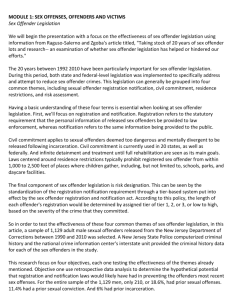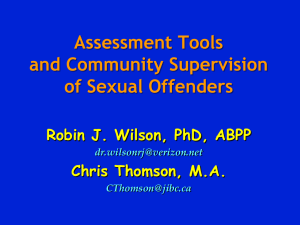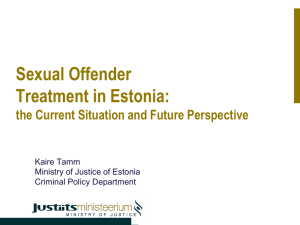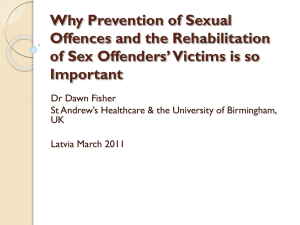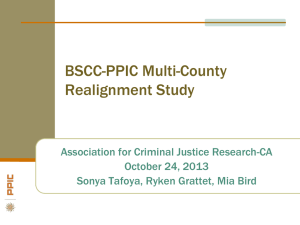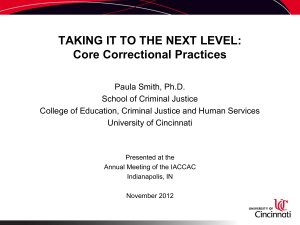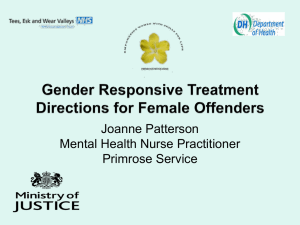Module Two – Assessment of Sex Offenders
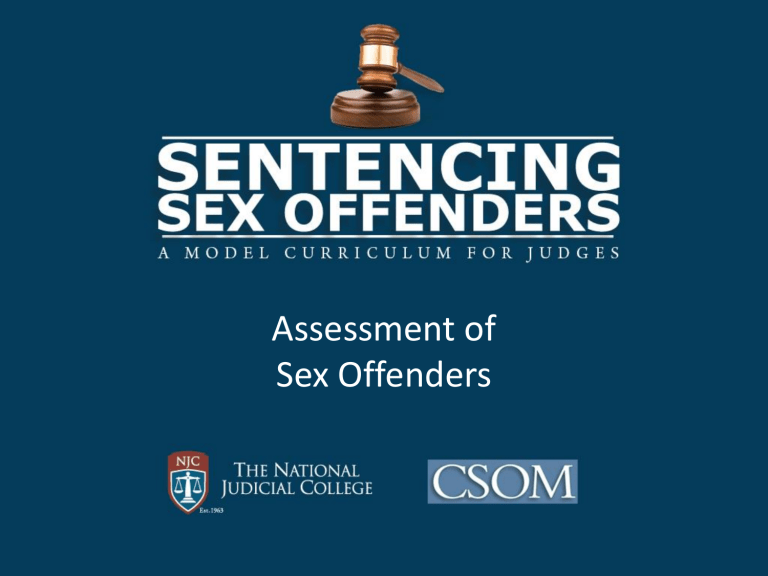
Assessment of
Sex Offenders
Learning Objectives
• Identify information and assessments that reliably estimate risk posed by sex offenders;
• Describe some of the areas of uncertainty in risk assessment of sex offenders; and
• Describe expected qualifications of professionals who conduct specialized, sex offender-specific assessments.
Types of Assessments That Can Inform
Decision-Making
Static and Dynamic Risk Factors
Commonly Accepted Sex Offender-Specific
Risk Assessment Tools
What to Expect in Assessments and From the Professionals Completing Them
Overview
Common Questions Courts Face in
Cases Involving Sex Crimes
• Is this defendant truly a “sex offender”?
• What type of sentence is warranted?
• How can justice and public safety concerns be reconciled in this case?
• Will this individual re-offend?
Questions Addressed through
Post-Conviction Assessments
• What level of relative risk does this individual pose?
• What factors indicate that this person is a greater (or lesser) risk to recidivate?
• Which strategies may be effective for this individual?
• Is this person likely to be amenable to strategies the court may utilize to positively affect risk reduction/management?
T YPES OF A SSESSMENTS THAT C AN
I NFORM D ECISION -M AKING
Key Assessments
• Risk assessments
– General and sex offender-specific
• Pre-sentence investigations
• Psychosexual evaluations
Important Assessment
Considerations
• Objectives
• Timing
• Method, approach
• Evaluator expertise
• Information access and sharing
Sources of Information for Assessments
• Offender interviews
• Collateral interviews
• Official records
• General psychological measures
• Sex offender-specific measures
• Empirically supported risk assessment tools
Identifying Higher vs.
Lower Risk Offenders
• Professional judgment
• Research-supported risk assessment tools
– General offenders
– Sex offenders
Predictive Accuracy of Risk Assessment
Strategies with Sex Offenders
Greater
Accuracy
1.0
0.8
0.6
0.4
.70
Less
Accuracy
0.2
0.0
.42
Professional
Judgment
Empirical
Actuarial
(Andrews & Bonta, 2007; Grove, et al., 2000; Hanson & Morton-Bourgon, 2007)
S TATIC AND D YNAMIC
R ISK F ACTORS
Two Categories of Risk Factors
• Static: generally unchangeable
• Dynamic: variable over time
Examples of Static Risk Factors for
Sex Offenders
Prior sex offenses
Prior non-sex offenses
Unrelated victims
Stranger victims
Young male victims
Deviant sexual arousal, interests, preferences
Examples of Dynamic Risk Factors for Sex Offenders
Sexual preoccupations
Access to victims
Intimacy deficits, conflicts in relationships
Pro-offending attitudes
Hostility
Non-compliance with supervision, treatment
Lifestyle instability
Static
Factors
Dynamic
Factors
Overall
Level of
Risk
Variables Not Linked to Sex
Offenders’ Recidivism
• Maltreatment history
• Emotional/psychological difficulties
• Poor clinical presentation
(Hanson & Morton-Bourgon, 2005)
Key Risk Factors in
Case Studies
Static vs. Dynamic Risk Factors
• Previous conviction for sex offense
• Desert Storm veteran
• Methamphetamine user
• Incest-only offense
• Clinically depressed offender
• Victim needs therapy for PTSD
C OMMONLY A CCEPTED S EX
O FFENDER -S PECIFIC R ISK
A SSESSMENT T OOLS
Risk Assessment Tools
• Minnesota Sex Offender Screening Tool -
Revised (MnSOST-R)
• Rapid Risk Assessment for Sexual
Offense Recidivism (RRASOR)
• Sex Offender Risk Appraisal Guide
(SORAG)
Risk Assessment Tools (cont.)
• STABLE- and ACUTE-2007
• STATIC-99, STATIC-2002
• Vermont Assessment of Sex Offender Risk
(VASOR)
• SVR-20
Sample Assessment: Static-99
1. Age (25 is cut-off)
2. Relationship > 2 years
3. Non-sexual violence with index event
4. Any prior non-sexual violence
5. Prior sex offense convictions (1, 2-3, 4+)
6. Prior sentencing dates
7. Non-contact convictions
8.-10. Unrelated, stranger, or male victims
Sexual Reconviction by Static-99
Score (%): Group Estimates
5 Years 10 Years 15 Years
Stan
1. Age: 22
2. No stable relationships
3. No sexual violence with offense
4. No prior non-sexual violence
5. No prior sex convictions
6. Prior sentencing dates: (less than four)
7. Two non-sexual assault convictions
8.-10. Known, but unrelated, male victim
Additional Tools
• Polygraph
• Viewing Time Measures (e.g., Abel
Assessment for Sexual Interest (AASI-2))
• Plethysmography
Polygraph
Polygraphs: Compare Admissions
Medium Number of Victims/Offenses Reported
Pre-Sentence
Report
Sexual History
Disclosure Form
First Polygraph
2 victims/5 offenses
8 victims/20 offenses
10 victims/22 offenses
Second Polygraph 11 victims/23 offenses
Similarly, the reported age of the first offense dropped from 28 to 12 from PSIs to polygraphs.
(Ahlmeyer, et al., 2000)
Polygraph: Compare
Victim Reports
Type of Crossover Court Polygraph
Adult & Child Victims 7% 70%
Male & Female Victims 9% 36%
223 Sex Offenders Participating in SOTMP TC at the
Colorado Department of Corrections
(Heil, Ahlmeyer, Simons, 2003)
Plethysmography
• Instrument to assess sexual arousal
• Arousal does not mean offender
• Ability to manage arousal may decrease recidivism risk
Abel Assessment for
Sexual Interest TM
• Assesses sexual interests via relative time spent viewing different visual stimuli
• Some research: can discriminate between offenders and non-offenders
• Undermined by websites that disclose the basis of the test
Commonly Accepted General Risk
Assessment Tools
• Level of Service Inventory-Revised (LSI-R)
• Violence Risk Appraisal Guide (VRAG)
• Statistical Information on Recidivism (SIR)
• Wisconsin Risk and Needs
• Correctional Offender Management Profiling for
Alternative Sanctions (COMPAS)
• Psychopathy Checklist (PCL-R)
Pre-Sentence Investigations
• Index offense
• Prior criminal history
• Social supports
• Health, mental health
• Employment, financial, residential stability
Pre-Sentence Investigations (cont.)
• Victim impact
• Aggravating, mitigating circumstances
• Findings from psychosexual evaluations
• Recommended criminal justice interventions
Commonalities Between General
Psychological and Sex
Offender-Specific Evaluations
• Intellectual, cognitive functioning
• Personality, psychopathology, diagnosis
• Interpersonal, social history
• Developmental, family history
• Risk of harm to self, others
W HAT TO E XPECT IN A SSESSMENTS
AND F ROM THE P ROFESSIONALS
C ONDUCTING T HEM
Expanded Content Important for Psychosexual Evaluations
• Sexual development, attitudes, behaviors, adjustment
• Sexual interests, arousal, preferences
• Sexual, violent recidivism risk
PSYCHOSEXUAL EVALUATION
I.
Identifying information
II.
Referral source and question
III. Informed consent
IV. Records review
V. List of assessment tools and strategies used (including offender interview)
VI. Background information, psychosocial history, employment
VII. Criminal history, responses to interventions
VIII.Sexual history
IX. Interpretations of assessment data, case formulation (including diagnosis, summary of intervention needs)
X. Recommendations
Assessing Evaluators’ Expertise
● Relevant advanced degree
● Forensic training, experience
● Specialized training, clinical supervision
● Licensure, professional affiliations
● Continuing education
Summary
• Assessments are essential for understanding sex offenders on a case-bycase basis.
• Research reveals specific factors linked to recidivism risk for sex offenders.
• Specialized, research-supported assessment tools increase accuracy of estimating risk.
Summary (cont.)
• Psychosexual evaluations provide added value over general psychological evaluations.
• Thorough, complementary assessments by quality evaluators can inform sentencing decisions.

